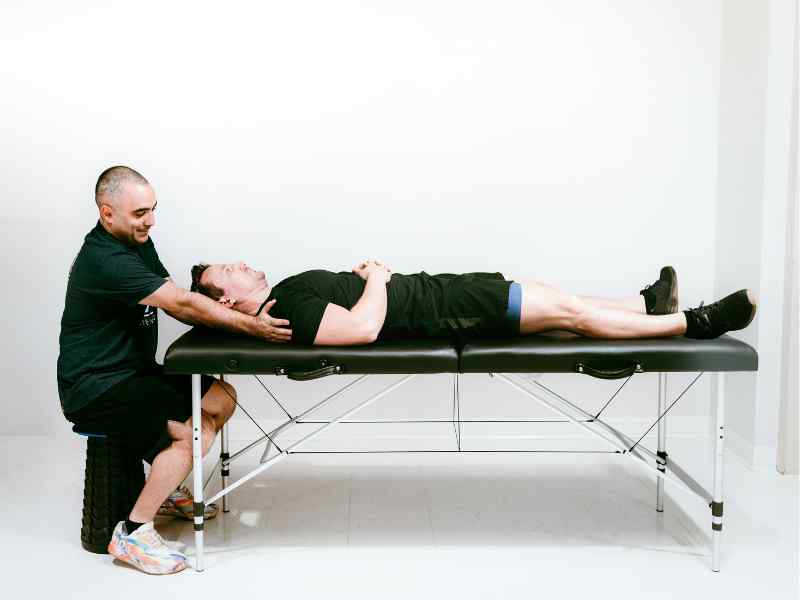Whiplash to Wellness: A Comprehensive Guide to Physical Therapy for Car Accident Injuries
Imagine driving home after a long day, your mind already at ease thinking about a relaxing evening. Suddenly, in a split second, you’re jolted by the impact of a car behind you. Amid the initial shock and confusion, a pain begins to emerge in your neck. This common scenario can lead to one of the most frequent car accident injuries: whiplash.
Whiplash is more than just a temporary discomfort; it’s a condition that can significantly impact your everyday life. In the United States, whiplash injuries are a prevalent outcome of vehicular accidents, affecting hundreds of thousands of individuals each year. According to a study published in the Journal of Orthopaedic & Sports Physical Therapy, an estimated 2 million Americans experience whiplash annually as a result of car accidents (1).
This condition not only causes physical pain but can also lead to prolonged discomfort, decreased mobility, and even long-term disability if not properly treated. Understanding whiplash injury is crucial, not just for those who have experienced it, but for anyone who’s on the road—which is practically all of us.
In this comprehensive guide, we delve into the depths of whiplash, especially following car accidents. We will explore its symptoms, causes, and most importantly, the pivotal role of physical therapy in the journey from injury to recovery. For anyone who has experienced whiplash or knows someone who has, this guide offers valuable insights into how physical therapy can pave the way to wellness, providing hope and actionable steps towards a pain-free life.
Keep reading to uncover how you can turn a moment of impact into a path to recovery and wellness.
What is Whiplash?
A whiplash injury occurs when the head is abruptly and forcefully thrown backward and then forward, most commonly as a result of a car accident or sports injury. This motion, reminiscent of the cracking of a whip, is where the condition gets its name.
At a physiological level, whiplash is the result of the neck’s muscles, tendons, and ligaments being rapidly stretched beyond their normal range of motion. The severity of whiplash can vary greatly. In some cases, it might only involve minor straining of the neck muscles and ligaments. However, in more severe instances, it can lead to torn ligaments, damaged muscles, fractured vertebrae, or joint dislocations.
Whiplash is particularly concerning because it often goes undiagnosed or is underestimated initially due to the delayed onset of symptoms. After the adrenaline and initial shock of a car accident subside, the symptoms may start to surface, highlighting the importance of medical attention even when no immediate pain is felt.
Symptoms of Whiplash
Whiplash symptoms can vary widely in intensity and duration, often depending on the severity of your injury or physical condition. Initially, some symptoms might seem mild or unrelated, but they can escalate or persist over time, significantly impacting daily life.
Here’s a list of symptoms commonly associated with a whiplash injury:
- Neck Pain and Stiffness: This is the most common symptom. The pain may worsen with movement and can range from slight discomfort to severe and debilitating pain.
- Headaches: Often starting at the base of the skull, these can be persistent and vary in intensity.
- Dizziness: A feeling of lightheadedness or unsteadiness is frequently reported.
- Blurred Vision: Temporary visual disturbances may occur.
- Fatigue: General tiredness or a feeling of being unusually drained or exhausted.
- Shoulder or Upper Back Pain: The force of the injury can also cause discomfort beyond just the neck, extending to the shoulders and upper back.
- Arm Pain or Weakness: Nerve damage or strain from the whiplash motion can lead to pain, tingling, or weakness in the arms.
- Ringing in the Ears (Tinnitus): Some people may experience a buzzing in their ears.
- Sleep Disturbances: Difficulty in falling or staying asleep can be common.
- Concentration or Memory Problems: These cognitive symptoms can include forgetfulness or difficulty focusing.
- Depression: In some cases, the ongoing pain and disruption of normal life can lead to feelings of depression.
Causes of Whiplash
While whiplash injuries are frequently associated with car accidents, it’s important to understand that there are various risk factors and causes that can contribute to this condition. Understanding these risk factors can help in recognizing situations where whiplash might occur and in taking preventive measures.
- Rear-end Car Collisions: The most common scenario for whiplash, where the sudden deceleration or acceleration causes the head to snap back and forth.
- Other Types of Car Accidents: Side-impact and front-impact collisions can also result in similar rapid head movements.
- Contact Sports: Activities like football, rugby, or martial arts, where sudden impacts can occur, can lead to similar neck movements and injuries.
- Physical Abuse or Assault: Incidents like being punched or shaken can mimic the rapid movement experienced in whiplash. This is also a concern in cases of shaken baby syndrome.
- Amusement Park Rides: Roller coasters or other high-speed rides that suddenly jerk or shake the body can cause similar neck strain.
- Falls: Falling in a way that violently jerks the head can lead to a whiplash-type injury.
Treatment Options for Whiplash
Effective treatment of a whiplash injury involves a multifaceted approach, tailored to your specific symptoms and severity. The goal of treatment is not only to alleviate pain and restore mobility, but also to expedite a return to normal daily activities.
Here are some of the primary treatment options for whiplash:
- Physical Therapy: Working with a specialized physical therapist involves techniques to restore neck mobility, exercises to strengthen muscles, and other modalities reduce pain. Therapists may use methods such as massage, heat therapy, cold therapy, ultrasound, and electrical stimulation, along with guided exercises. Physical therapy is crucial in preventing chronic pain and aiding in a faster recovery. Request care with one of our therapists here.
- Pain Management Medications: Over-the-counter pain relievers like acetaminophen (Tylenol) or NSAIDs (such as ibuprofen) are often recommended for mild to moderate pain. In more severe cases, prescription painkillers or muscle relaxants may be used but only after the recommendation of a physician.
- Rest or Modified Activities: Initially, short periods of rest can be beneficial. However, prolonged inactivity may lead to a worsening of any symptoms. Gradual return to normal activities is usually advised.
- Alternative Therapies: Some individuals find relief through acupuncture, chiropractic treatment, or yoga. These therapies should complement, not replace, the primary treatment plan.
- Surgery: In very rare cases, where there is severe injury to the neck structures, surgery may be necessary. This is typically considered only when other treatments have failed and there is evidence of nerve or spinal cord compression.
Note: Although cervical collars were once a standard treatment for whiplash, current guidelines suggest limited use as they can weaken neck muscles over time.
In cases of car accident claims, you’ll likely be working closely with attorneys and insurance companies. They can help manage the legal and financial aspects, ensuring access to necessary treatments and compensations. This process can be integral to the recovery journey, particularly in covering medical expenses and therapy costs.
The benefits of physical therapy, specifically, go beyond just treating the symptoms of whiplash. It also plays a vital role in restoring function, preventing chronic pain, and improving overall quality of life. In the following section, we’ll explore in-depth how physical therapy specifically aids in the recovery from whiplash, especially post-car accidents.
How Physical Therapy can help with Whiplash
Physical therapy is a cornerstone in the treatment and management of whiplash, especially after a car accident. Working with a skilled physical therapist can significantly aid in a more rapid and comprehensive recovery. Here’s how:
- Personalized Treatment Plans: Each case of whiplash can present differently. Physical therapists develop tailored treatment plans based on individual symptoms, severity, and recovery goals. This personalized approach ensures that therapy addresses specific needs.
- Pain Management: Physical therapists employ techniques like soft tissue mobilization, massage, and trigger point therapy to reduce pain in the neck or other areas. These methods help in relaxing tight muscles and increasing blood flow to the injured area, aiding in pain relief and healing.
- Restoring Range of Motion: Gentle stretching and mobilization exercises are used to restore the neck’s flexibility. Therapists guide patients through specific movements designed to gradually increase the range of motion without aggravating the injury.
- Strengthening Exercises: To support the neck and prevent future injuries, physical therapists teach exercises that strengthen your neck, shoulder, and upper back muscles. These exercises are crucial for long-term recovery and maintaining neck health. Rather than list generic exercises here, we recommend signing up for care with a MovementX physical therapist to receive a personalized program.
- Posture Education: Patients are educated on maintaining proper posture, especially during activities that might strain the neck. This education is vital for preventing re-injury and managing symptoms.
- Functional Training: Therapy includes training in how to perform daily activities safely, reducing strain on the neck and preventing aggravation of symptoms.
Note on Legal Claims: Detailed documentation of injuries, treatment plans, and progress provided by physical therapists can be vital in substantiating a legal claim related to car accidents. This documentation is often required by car accident lawyers, attorneys, or insurance companies to demonstrate the extent of injury and the necessity of treatment.
Advice on Choosing the Best Clinic or Physical Therapist
- Qualifications and Specializations: Look for clinics or therapists like those at MovementX who specialize in whiplash or car accident injuries. Ensure they are licensed and have relevant experience.
- Personalized Care Approach: Choose PTs who offer personalized treatment plans rather than a one-size-fits-all approach.
- Convenient Location: For ongoing treatment, consider a clinic that is easily accessible. Search for “car accident injury clinic” or “auto accident physical therapy near me” for localized options.
- Insurance and Legal Coordination: Ensure the clinic has experience working with insurance claims and can coordinate with legal representatives if necessary.
Conclusion
Whiplash, especially following a car accident, is more than just a temporary setback; it can be a pivotal moment in one’s health journey. But how do you navigate this path from injury to wellness? Are you equipped with the right info and resources to make a full recovery? Remember, the choices you make in the aftermath of an accident can significantly influence your overall recovery trajectory.
At MovementX, we believe in turning these challenging moments into opportunities for healing and growth. Our specialized physical therapy approach is designed to address not just your symptoms of whiplash but to empower you with the tools and knowledge for long-term health and well-being. Have you considered how personalized physical therapy can aid in your recovery? Are you ready to take the first step towards a pain-free life?
We encourage you to reach out and request a session with MovementX. Our team of expert therapists is ready to guide you on your journey from Whiplash to Wellness, ensuring you receive a personalized care plan and the support you deserve. Take that decisive step today – your path to recovery and optimal health is just a consultation away.
About the Author
Dr. Keaton Ray is a physical therapist in Portland, OR and Chief Operations Officer at MovementX. She is a Board Certified Specialist in Orthopedics, a spine specialist, and a certified strength and conditioning coach. Keaton Ray utilizes a combination of strength training and hands-on manual therapy to help her patients move their best so they can live their best. She loves helping people learn how to walk again, train for a marathon, and everything in between.
Share This Page
More Conditions We Treat
Found this page interesting? Learn more about other conditions we treat:





